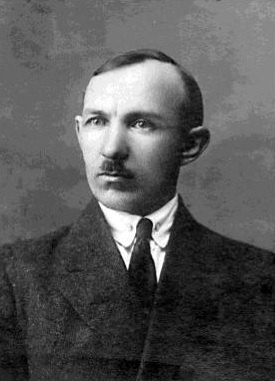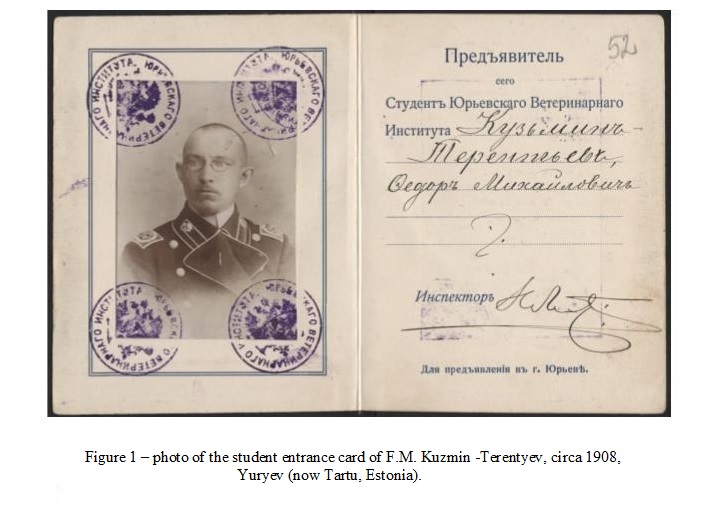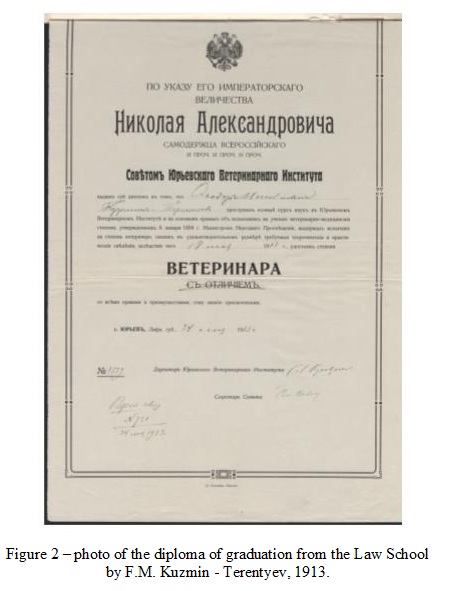


KUZMIN-TERENTYEV Fedor (Feodor) Mikhailovich (born March 17 (29), 1886 – died October 21, 1937) was a military veterinarian, a prominent figure in practical veterinary medicine, an organizer of science and higher veterinary education in Kazakhstan [1, 2, 3].
F.M. Kuzmin-Terentyev was born in the village of Kholui in the Vyaznikovsky district of the Vladimir province in the family of a senior military paramedic in the reserve [1, l. 6]. Until February 6 (18), 1912, he alternately bore the surname Kuzmin, then Terentyev. After the specified date, the Vladimir Spiritual Consistory allowed him and his younger brother to bear the double surname “Kuzmin-Terentyev” [1, l. 22-22 vol.].
After graduating from Shuisky Theological College, F.M. Kuzmin-Terentyev entered the Vladimir Theological Seminary. After completing the course of grades I-IV of the Vladimir Theological Seminary, in October 1906 he continued his studies at the Orenburg Theological Seminary, which he graduated in June 1908, which gave him the opportunity to enroll in university or institute [1, LL. 8, 66-67]. On August 2 (15), 1908, F.M. Kuzmin-Terentyev was accepted as a first-year student of the Yuriev Veterinary Institute (YUVI) [1, L. 3].
In the process of studying at the YUVI, F.M. Kuzmin-Terentyev passed the tests for a degree in the subjects studied from I to IV courses and practice in surgical and therapeutic clinics [1, l. 39-49, Fig.1].
On May 18 (31), 1913, F.M. Kuzmin-Terentyev graduated from the Southern Medical Institute and was awarded the degree of veterinarian, having received temporary certificate No. 731 dated May 24 (June 5), 1913 with a validity period of 6 months, until the original diploma of a special sample was issued to him [1, LL. 61-62, fig. 2].
F.M. Kuzmin-Terentyev began his career on September 1 (14), 1913, having decided to serve in the 17th Chernigov Hussar Regiment as a junior veterinarian [2, p. 81].
During the 1st World War (1914-1915), he was in the active army, at the front, with his regiment in Austria [3, l. 226], where he served until July 24 (August 5), 1915 [3, l. 228].
From the end of July (beginning of August) 1915 to January 11 (24), 1918 F.M.
Kuzmin-Terentyev served in the Minsk District Military Veterinary Administration as a clerk [3, l. 228].
From May to September 1918, F.M. Kuzmin-Terentyev was in charge of the sanitary and hygienic laboratory of a medical profile in Orenburg (later – KIEM, currently – the State Research and Development Committee “Scientific Center of Hygiene and Epidemiology named after Hamza Zhumatov” of the Ministry of Health of the Republic of Kazakhstan, Almaty) [3, L. 228, 5, 6].
From September 1918 to February 1920, F.M. Kuzmin-Terentyev, upon mobilization, served in the District Administration in the ranks of the white army of General A.I. Dutov as a veterinarian [3, l. 228, 4, l. 21 vol.].
From May 1920 to September 1922, he served in the ranks of the Red Army as a veterinarian of the staging battalion and head of the Tashkent Military Veterinary infirmary [3, l. 228].
In the autumn of 1922, F.M. Kuzmin-Terentyev was demobilized from the Red Army and came to Orenburg, where on September 22, 1922 he was appointed head of the Central Veterinary and Bacteriological Laboratory (CVBL) of the People’s Commissariat of Agriculture (NKZ) of the KASSR, where he worked until February 6, 1923 [3, l. 226 vol., 7On
February 6, 1923, F.M. Kuzmin-Terentyev was transferred to the managing director of the veterinary department [3, l. 226 vol.] and was elected a member of the Board of the NKZ KASSR [2, p. 82].
In view of the outbreak of rabies among farm animals on the territory of the KASSR, in December 1923, F.M. Kuzmin-Terentyev gave recommendations to the provincial executive committees on trapping stray dogs [8].
To establish the standard of veterinary care for livestock, the veterinary department on May 24, 1924 requested data on the number of livestock and the staff of veterinary workers in the provinces and regions of the republic [8, l. 191].
After being appointed to the post of manager of the veterinary department of the NKZ KASSR, F.M.Kuzmin-Terentyev, when filling out the personal sheet of the responsible employee No. 34 dated August 14, 1924, changed the official date of his birth on March 29, 1886, for reasons unknown to us, to March 2, 1886 [3, l. 226, 4, L. 21].
Under the leadership of F.M.Kuzmin-Terentyev, annual reports of the veterinary department of the NKZ KASSR were compiled annually, which reflected the state of veterinary affairs in the republic [9].
In 1924, F.M. Kuzmin – Terentyev, through the provincial departments, took strict quarantine measures to prevent the spread of infectious diseases of farm animals into the republic and within its provinces and regions [10].
F.M. Kuzmin-Terentyev put a lot of effort and energy into the reorganization of the Central Research Institute in 1924-1925 into the Kazakh Regional Veterinary and Bacteriological Institute (KKVBI), since 1932 – KazSRVI) and its further formation [2, p. 82].
Under the leadership of F.M. Kuzmin-Terentyev, measures were carried out in Kazakhstan to combat and eliminate rabies, equine glanders, anthrax, bovine pneumonia, actinomycosis, tuberculosis, sheep pox, emphysematous carbuncle of cattle, foot-and-mouth disease, pasteurellosis, porcine erysipelas, horse strangles, infectious equine encephalomyelitis, helminthiasis, scabies, trypanosomiasis of camels [11].
In accordance with Order No. 109 of September 22, 1926 on the NKZ of the KASSR, F.M. Kuzmin-Terentyev took part in the work of the All-Union Veterinary Scientific and Organizational Congress [12].
At the end of 1926, a demonstration was held by students led by a representative of the Alma Ata Vetzootechnikum, dissatisfied with the Bolshevik government, which brought the students to a beggarly existence. In this regard, F.M. Kuzmin-Terentyev asked in his letter the People’s Commissariat of Education of the KASSR to resolve this situation, limiting himself only to working on this issue with the administration of the Alma-Ata vetzootechnikum [13].
On April 11, 1928, with the assistance of F.M. Kuzmin-Terentyev, funds were allocated for the opening of the Pasteur station at KKVBI (KazSRVI) in the city of Kyzyl-Orda [14].
F.M. Kuzmin-Terentyev worked as the head of the veterinary department and a member of the board of the NKZ KASSR until July 1928, and in September of the same year he was appointed a member of the political and educational committee of the republic from the NKZ KASSR [15].
In early 1929, the government of Kazakhstan entrusted F.M. Kuzmin-Terentyev with the organization of the Kazakh State Veterinary Institute (AZVI), appointing him secretary of the Council and board of the Institute. He coped with this important task of organizing the AZVI and selecting teaching staff for it with honor: on October 1, 1929, the official opening of the AZVI took place in Alma-Ata [2, pp. 82, 16].
In accordance with Order No. 45 of the Kazakh State Veterinary Institute (AZVI) dated February 1, 1930, the secretary of the Council and board of the Institute, F.M. Kuzmin-Terentyev, was dismissed at his own request and on the basis of a telephone message from the head of the Veterinary Department No. 2-e [17].
We do not know anything about the period of activity of F.M. Kuzmin-Terentyev from February 1930 to 1934 inclusive.
It was established that by 1935 F.M. Kuzmin-Terentyev worked as the head of the veterinary department of the Minusinsk trust of dairy farms of the Krasnorsky Territory [18].
On October 6, 1936, F.M. Kuzmin-Terentyev was arrested and detained at the Minusinsk prison, where on October 7, 1936, he was presented with a decision on the election of a preventive measure and charges of sabotage [4, L. 18].
By October 15, 1936, he was transferred from the UGB of the NKVD Directorate for the Krasnoyarsk Territory to the Krasnoyarsk prison [4, l. 21-21 vol.].
During the years of mass political repression in the USSR, state security investigators, when the accused refused to bring charges against them, constantly resorted to interrogations using methods prohibited by law (mainly torture). After such interrogations, this is what F.M. Kuzmin-Terentyev had to say to the state security investigator during the interrogation on December 5, 1936: “Yes, I must admit that so far I have given false testimony to the investigation, denying the existence of subversive work in the trust and personal participation in it” [19]. It should be emphasized at the same time that the interrogation protocols, where F.M. Kuzmin-Terentyev completely denied his guilt for two months, not in the criminal case, since they were probably destroyed by the investigation. It was in this way that all political criminal cases in the USSR were falsified under Stalinism.
On July 1, 1937, a special board of the Krasnoyarsk Regional Court sentenced F.M. Kuzmin-Terentyev allegedly for participating in a “counter revolutionary wrecking group” under Articles 58-7 and 58-11 of the Criminal Code of the RSFSR to capital punishment – execution, with confiscation of personally owned property [20, 21].
The court’s verdict against F.M. Kuzmin-Terentyev was carried out on October 21, 1937.
Fyodor Mikhailovich was buried in Krasnoyarsk [22].
August 9, 1957 The Presidium of the Supreme Court of the RSFSR, having considered the protest of the Deputy Prosecutor of the RSFSR, decided the verdict of the Special Board of the Krasnoyarsk Regional Court of July 1, 1937 and the ruling of the Special Board of the Supreme Court of the RSFSR of October 2, 1937 in relation to Kuzmin-Terentyev F.M., to cancel, the case should be terminated due to the lack of evidence of the charge [18, LL. 171-176].
REFERENCES:
- Estonian Historical Archives. EAA. 404.1.2194. Case of the Chancellery of the Yuriev Veterinary Institute. Kuzmin-Terentiev Feodor Mikhailovich. LL. 1-69.
- Mamedov N.Sh. Activity of the Central (Kazakh Krai veterinary-bacteriological laboratory (1917-1925) / In the book: Scientific support of veterinary problems in animal husbandry in Kazakhstan: Collection of scientific works. – Volume 52. – Almaty, 2006. – P. 78-86.
- Archive of the President of the RK. Ф. 139. Op. 1. Д. 1016. LL. 226-228.
- KCU “GACC” RF. F. R-2400. D. P-7817. Т. 1. LL. 18, 21 – 21 ob.
- Mamedov N.Sh. Materials to the history of the Kazakh Institute of Epidemiology and Microbiology (KIEM) // Hygiene, Epidemiology and Immunobiology. – Almaty, 2006. – № 1. – P. 122-129.
- Mamedov N.Sh. Historical literature on the emergence of the first research institutions in Kazakhstan: fiction and reality // Veterinary. – Abay village of Almaty region, 2010. – № 6. -P.68-72.
- TSGA RK. F. 74. Op. 8. D. 7. L. 92.
- TSGA RK. F. 74. Op. 2. Д. 421. LL. 170, 19
- TSGA RK. F. 74. Op. 8. Д. 57. St. 4. LL. 31-32.
- TSGA RK. F. 74. Op. 2. Д. 428. L. 175.
- TSGA RK. F. 74. Op. 8. Д. 113. LL. 32-71.
- TSGA RK. F. 74. Op. 8. Д. 122. L. 225.
- TSGA RK. F. 74. Op. 8. Д. 150. LL. 320-321.
- GAKO RK. Р-191. Op. 1. Д. 44. L. 312.
- URL: www.centrasia.ru
- Kazakh State Agrarian University – 70: Collection (Compilation and foreword by S.B.Baizakov). – Almaty: Agrarian University, 1999. – С. 15.
- Archive of KazNAU. Op. 1-l. St. 1. 1929-1931. LL. 19 ob. – 20.
- KGKU “GAKK” RF. F. R-2400. D. P-7817. Т. 8. LL. 171-176.
- KGUKU “GAKK” RF. F. R-2400. D. P-7817. Т. 2. L. 52.
- KGUKU “GAKK” RF. F. R-2400. D. P-7817. Т. 6. LL. 238-249.
- KGKU “GAAK” RF. F. R-2400. D. P-7817. Т. 7. Л. 113. 22. URL: www.lists.memo.ru/index11.htm